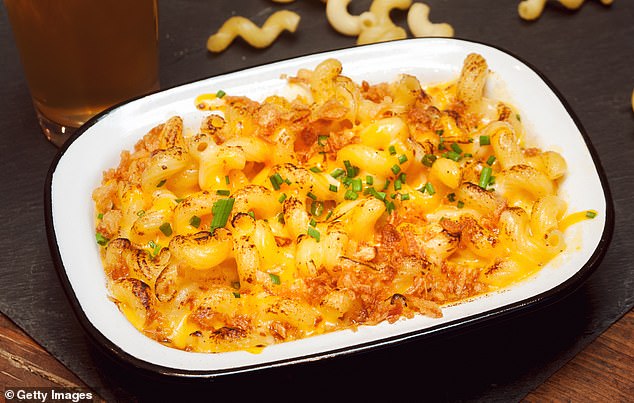The hormone-disrupting chemical used in ROCKET FUEL is widespread in ready-made macaroni and cheese and other common foods
Research has found that a hormone disrupting chemical used in the production of rocket fuel is prevalent in American foods.
The watchdog Consumer Reports found it Perchlorate was found in dozens of types of fresh fruit, fast foods including hamburgers and fries, and children’s foods such as macaroni and cheese.
Perchlorate is used in rocket fuel, missiles, explosives, airbags and certain plastics. It leaches into food and water when accidentally released or improperly disposed of at industrial sites where these products are made.
When crops are irrigated with polluted water, the produce becomes contaminated with this water.
Baby/children’s food, fast food and fresh fruits and vegetables contain the highest concentrations of the compound perchlorate
None of the foods contained a perchlorate concentration in a single serving that would be problematic.
But most Americans eat more than the recommended serving, putting them at risk of even greater exposure to the contaminant.
Children may be at particular risk due to their lower body weight.
Perchlorate is known to affect human hormone levels and harm the thyroid gland.
It has been shown to interfere with the body’s ability to absorb iodine, which is essential for hormone production. This can lead to chronic metabolic disorders such as diabetes.
In pregnant women, exposure to perchlorate may contribute to neurological disorders in their babies.
Because the environment is usually too cold to activate its degradation, perchlorate ions can persist unchanged in the air, soil and water for decades.
The researchers looked at 196 samples of 63 supermarket products and 10 fast food products. These samples were chosen because previous scientific research had shown that these foods may contain perchlorate.

Baby and infant foods, such as macaroni and cheese, baby cereals and yogurt, all tested positive for perchlorate
Baby food had the highest concentration of perchlorate, with foods containing an average of 19.4 parts per billion.
Researchers at Consumer Reports found that the amount of perchlorate in a single serving of macaroni and cheese from a packet — a classic children’s meal — would exceed nearly 50 percent of the European Food Safety Authority’s maximum safety limit of 0.3 micrograms per kilogram of body weight.
Servings of baby rice porridge, baby multigrain porridge and organic yoghurt would each reach about a quarter of that limit.
‘This means that a child consuming one portion of each of the above foods, which is quite possible in a single day, would exceed the EFSA safe daily limit.’
They added that the amount of perchlorate in one portion of fruit or vegetables, such as cucumbers and young carrots, would account for 50 percent of the European maximum safety limit.
Fruits and vegetables had a perchlorate concentration of 9.3 ppb, while fast food had a concentration of 7.7 ppb.
Even healthy foods are not safe from contamination, the authors wrote.
When testing foods and packaging, scientists measured amounts in parts per billion (PPB).
Foods in plastic packaging contained the highest concentrations of perchlorate, at 54 ppb, followed by foods in plastic wrap and cardboard.
While the EFSA uses a daily maximum recommended limit of 0.3 micrograms per kilogram of body weight per day, the EPA uses a significantly higher threshold of 0.7 micrograms per kg of body weight.
The US Environmental Protection Agency uses a maximum safety threshold that is higher than the European one.
Tunde Akinleye, the CR chemist who oversaw the perchlorate test, says many food safety experts believe this level is not protective enough and should be significantly lower.

A portion of children’s food such as macaroni and cheese from a packet would exceed almost 50 percent of the European legal limit
Perchlorate is one of thousands of chemicals currently allowed in the foods on supermarket shelves.
When manufacturing plants that build rockets and missiles use perchlorate to power their inventions, the sludge from that fuel seeps into the groundwater, potentially contaminating the water we drink and the water farmers use for their crops.
The Environmental Working Group tested lettuce for perchlorate in 2003 to gauge the level of contamination. The farm the lettuce came from was downstream from Lake Mead, where two perchlorate production facilities operated until the 1990s.
They found perchlorate in 20 percent of the lettuce samples from supermarkets.
The compound is also used in the development of plastics to reduce static charges. For example, baby food containers often contain perchlorate, which then contaminates the food they encase.
It can also get into food that comes into contact with bleach. Bleach is used as a disinfectant in food processing and to peel and wash fruits and vegetables.
The likelihood of perchlorate causing thyroid damage depends on baseline iodine levels. Iodine is a mineral that is crucial for hormone production, the thyroid’s primary function.
But far too few pregnant women get enough of it, putting them at greater risk for negative consequences from perchlorate exposure, including abnormal fetal brain development, lower IQ, and poor maternal health, such as weight gain, fatigue, and depression.
More people are iodine deficient now than half a century ago. Nearly 25 percent of pregnant women in the U.S. don’t get enough.
The EPA has promised for years to change the maximum safety limits for perchlorates, but has yet to follow through on that promise. California (6 ppb) and Massachusetts (2 ppb) have already done so.
The CR researchers concluded: “When EPA actually proposes limits, which the agency has indicated it will do by 2025, setting strict limits like these could spur cleanup efforts in contaminated areas.”
